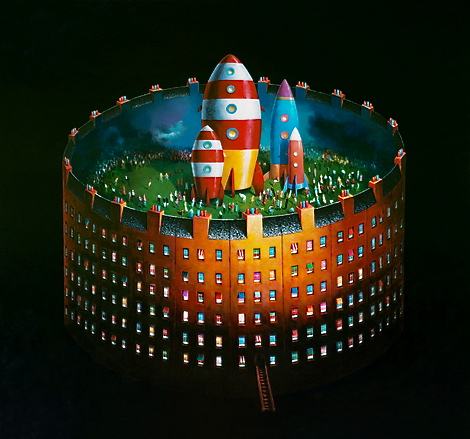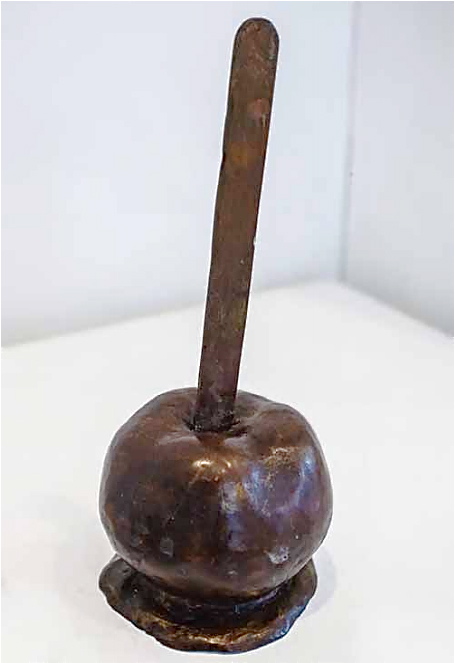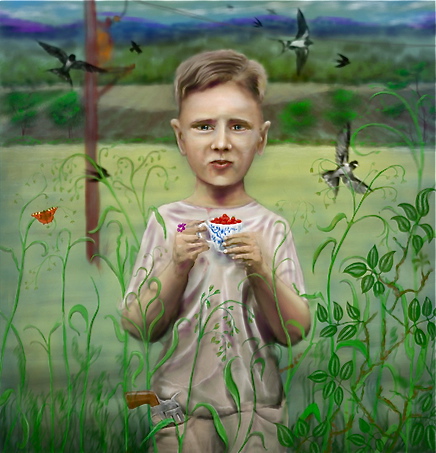
‘Kill'em! Strangle'em! Don't let go! Kill'em! Kill'em! Kill'em ALL!!’
So says Chucky in the 1988 horror film Child’s Play, capturing rather neatly the dark territory children enter alarmingly often and quickly with unfettered imagination.
Play can be profoundly creative and amoral. It gives licence to the violence of make-believe. It sets few bounds. It rarely apologises. It is the kitten's enjoyable rehearsal of a kill.
Something of that liberating darkness pervades much of the new work at Union Gallery, a group exhibition by seven artists invited to respond to Child’s Play as a theme by gallery director Alison Auldjo.
I am new to the work of Mary Archibald, and pleasantly unsettled by the rumpled, rottten-potato quality of her effigies. ‘Ma Hoop’ and ‘Ma Ba’ recall the feral qualities of Archibald’s own childhood. She speaks of ‘bringing to life’ these pieces, of letting her inner ‘bad girl out to play’. I found 'The Christening' (above) absolutely terrifying.
In Samantha Boyes’ case, the meaning of a female mallard’s head on Donald Duck body is obscure. But the effect is – as noticed before with her work – somewhere uncomfortable between laughter and disgust (Breaking news, 1.12.14). Her prancing creatures in kitsch tartan perhaps warn us not to judge truth by outward appearances, not to find only amusement when Death comes dressed in harlequin.
Her pieces force from me a series of knee-jerk reactions, but I don’t find her work remotely trivial. I am interested by, and attracted here to, the repulsion I experience in considering it.
We return to monsters in Heather Nevay’s marvellous and peculiar ‘Chorus of Disapproval’.

Have birds transformed into humans? Is that why they needed ladders to descend from their nests? Or have humans used ladders to kill birds or steal their eggs? Was some such theft and consumption necessary for the woman to change into a bird herself? To whom do all those blue shoes belong, and where have they gone? Has somebody swallowed them?
These and many other questions are raised, like empty ladders, and not answered. It is a tantalising enigma.
Another ladder leads to what looks like a crime scene in ‘The Doll's House’ (below). A nestlike home has been opened and rummaged. The bed is disturbed. Chairs have been knocked over; one is still falling, caught in mid-air. There’s no sign of an intruder or victim, and no sign that the countryside around has noticed or been disturbed. It is a scene of exquisite strangeness, and reminiscent of Bruegel's 'Landscape with the Fall of Icarus'.
Another newcomer to the Union Gallery is David Schofield, whose ‘The Reluctant Spaceman’ (below) is a mixture of the familiar and the surreal. I enjoyed its circular tenements and the back-green amphitheatre at their centre. I liked the naive space rockets, and the paradoxical, TARDIS-like, infinite interior of the wall. Some people find Schofield’s works foreboding – I thought this one had the dreadful optimism of dreams, and I liked it for that.


Kevin Low writes of his work in the exhibition catalogue:
All of this happens in Angus, in the woods and cool green corners there. It’s important that you know that. Brechin, Forfar and Montrose are the queer triangle of sandstone towns that mark out my world.
These were places that when circuses came, elephants in chains paraded past the butchers’ shops. This was a place where once upon a time I stood in a field and waved as the last steam train passed on its way to Aberdeen. I was that boy who played sunburned amongst the stooks. I was the quiet one you had to watch. I wandered through fields, explored dark corners. People hid in the woods and kissed, and children died. Me, I had a spear with a barbed wire tip and a flag and a plywood shield – once a cupboard door – for sheltering safe beneath.
I love that description, and I love this painting – ‘Paradise’ – one of the most beautiful I have seen by him, and one of the happiest. The expression in the eyes is slightly wary, that toy pistol suggests that even paradise may prove finite for the unwary, but by Low's standards of ambivalent complication this is positively euphoric.

Olivia Irvine is a regular exhibitor at the Union Gallery, and a particular favourite of this reviewer. To my mind, her ‘Still Life’ is a highlight of the show.
So often in Irvine’s work, it is her peculiar angle of view and field of vision which gives the painting its power. She manages to convey a sense of how she or her imagined viewer is concentrating.
Here, she seems to view from the height of a child the objects which a child finds fascinating. They are laid out on top of a bed, perhaps a trove of stolen treasures, each ready for minute examination, comparison, evaluation.
What lies beneath the bed has been rendered deliberately vague. There lies the personal den, the privacy of imagination, the inside of the skull, another infinite interior within confined space.
I relish Irvine’s empathetic candour, could stare for hours at those generous blues and reds and greens. AM